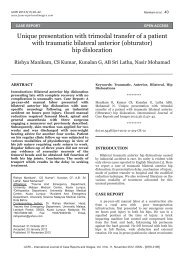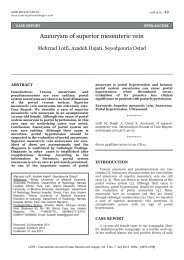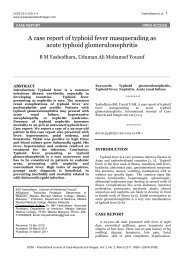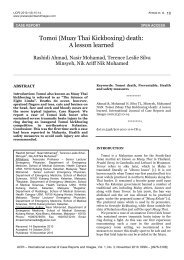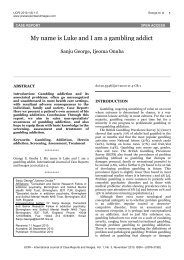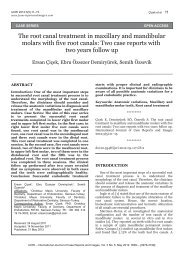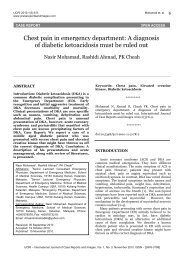Full Text PDF - International Journal of Case Reports and Images ...
Full Text PDF - International Journal of Case Reports and Images ...
Full Text PDF - International Journal of Case Reports and Images ...
You also want an ePaper? Increase the reach of your titles
YUMPU automatically turns print PDFs into web optimized ePapers that Google loves.
IJCRI 201 2;3(8):51 –56.<br />
www.ijcasereports<strong>and</strong>images.com<br />
Aswath et al. 51<br />
CASE IN IMAGES<br />
OPEN ACCESS<br />
Pimary hyperparathyroidism as central giant cell<br />
granuloma <strong>of</strong> the jaws: Pre <strong>and</strong> posttreatment pattern<br />
<strong>of</strong> clinical <strong>and</strong> radiographic presentation<br />
Nalini Aswath, Pravda Chidambaranathan<br />
ABSTRACT<br />
Introduction: The parathyroid gl<strong>and</strong>s regulate<br />
serum calcium <strong>and</strong> phosphorous levels by its<br />
secretion <strong>and</strong> maintenance, within physiological<br />
limits, <strong>of</strong> its hormone parathormone (PTH).<br />
Hyperparathyroidism is a metabolic disorder<br />
resulting from excessive secretion <strong>of</strong><br />
parathyroid hormone. Hyper secretion might<br />
occur either due to a primary pathology in the<br />
gl<strong>and</strong>s (or) due to secondary causes. Central<br />
giant cell lesions occur in jaw bones. <strong>Case</strong><br />
Report: A 20yearold boy reported with<br />
complaints <strong>of</strong> swelling in left maxilla. Intra<br />
orally swelling extended from left upper canine<br />
till left upper second premolar <strong>and</strong> caused<br />
expansion <strong>of</strong> the cortical plates. Intra oral<br />
radiograph <strong>and</strong> orthopantomograph showed a<br />
poorly defined radiolucent lesion in between left<br />
upper canine <strong>and</strong> left upper 1st premolar with<br />
multiple cystic cavities in the region <strong>of</strong> the<br />
symphysis, left body <strong>and</strong> right angle <strong>of</strong><br />
m<strong>and</strong>ible. The radiographs <strong>of</strong> long bones showed<br />
osteoporosis. Serum alkaline phosphatase level<br />
was raised. Histopathology was reported as<br />
central giant cell granuloma. Nuclear scan <strong>of</strong><br />
parathyroid showed a functioning parathyroid<br />
adenoma. The swelling in left maxilla regressed<br />
Nalini Aswath 1 , Pravda Chidambaranathan 2<br />
Affiliations: 1<br />
Pr<strong>of</strong>essor & Head <strong>of</strong> Department-Sree Balaji<br />
Dental College <strong>and</strong> Hospital, Chennai, Tamilnadu, India;<br />
2<br />
Reader-Sathyabama Dental College <strong>and</strong> Hospital,<br />
Chennai Tamil Nadu, India.<br />
Corresponding Author: Dr. Nalini Aswath, “Mathuram”, Plot<br />
No:1 61 , #5, Murugu Nagar 5 th street, Velachery, Chennai,<br />
Tamil Nadu, India - 600042; Ph: +91 -044-22591 51 9; Mob:<br />
91 - 94441 -61 841 ; Fax: +91 -044-22460631 ; Email:<br />
naliniaswath@gmail.com<br />
Received: 20 December 2011<br />
Accepted: 1 2 April 201 2<br />
Published: 01 August 201 2<br />
on its own after the adenoma <strong>of</strong> the<br />
parathyroids was excised. Conclusion: Timely<br />
diagnosis <strong>of</strong> parathyroid adenoma results in<br />
total regression <strong>of</strong> intra oral swelling <strong>and</strong><br />
further progression <strong>of</strong> osteoporosis <strong>and</strong><br />
fractures <strong>of</strong> long bones can be prevented.<br />
Keywords: Central giant cell granuloma, Brown<br />
tumor, Hyperparathyroidism<br />
*********<br />
Aswath N, Chidambaranathan P. Pimary<br />
hyperparathyroidism as central giant cell granuloma <strong>of</strong><br />
the jaws: Pre <strong>and</strong> post treatment pattern <strong>of</strong> clinical <strong>and</strong><br />
radiographic presentation. <strong>International</strong> <strong>Journal</strong> <strong>of</strong><br />
<strong>Case</strong> <strong>Reports</strong> <strong>and</strong> <strong>Images</strong> 2012;3(8):51–56.<br />
*********<br />
doi:10.5348/ijcri201208167CII14<br />
INTRODUCTION<br />
The parathyroid gl<strong>and</strong>s regulate serum calcium <strong>and</strong><br />
phosphorous levels by secretion <strong>and</strong> maintenance,<br />
within physiological limits, <strong>of</strong> its hormone<br />
parathormone (PTH). Secretion <strong>of</strong> PTH is mainly<br />
controlled through interaction <strong>of</strong> calcium with calcium<br />
sensitive receptors on the membrane <strong>of</strong> the parathyroid<br />
cells. Hyperparathyroidism is a syndrome <strong>of</strong><br />
hypercalcemia resulting from excessive secretion <strong>of</strong><br />
parathyroid hormone. A case <strong>of</strong> central giant cell<br />
granuloma in left maxilla due to adenoma <strong>of</strong><br />
parathyroid gl<strong>and</strong> is presented.<br />
CASE REPORT<br />
A 20yearold boy reported with complaints <strong>of</strong><br />
swelling in the left upper jaw (Figure 1). The swelling<br />
IJCRI – <strong>International</strong> <strong>Journal</strong> <strong>of</strong> <strong>Case</strong> <strong>Reports</strong> <strong>and</strong> <strong>Images</strong>, Vol. 3 No. 8, August 201 2. ISSN – [0976-31 98]
IJCRI 201 2;3(8):51 –56.<br />
www.ijcasereports<strong>and</strong>images.com<br />
Aswath et al. 52<br />
was initially smaller six months ago <strong>and</strong> gradually<br />
increased in size. It was asymptomatic since onset <strong>and</strong><br />
had not regressed in size at any time. There was no<br />
history <strong>of</strong> discharge from the swelling. No history <strong>of</strong><br />
paresthesia or fever. The past medical history <strong>and</strong><br />
surgical histories were unremarkable. Patient was<br />
moderately built, well nourished, calm <strong>and</strong> cooperative.<br />
His growth appeared to be retarded to his<br />
age. His vital signs were stable. A single left subm<strong>and</strong>ibular<br />
lymph node was enlarged, palpable,<br />
nontender, measuring 1 cm/1 cm in size, firm in<br />
consistency <strong>and</strong> mobile.<br />
Extra oral examination revealed a solitary swelling ,<br />
with well defined margins, measuring 3 cm/3 cm in<br />
diameter in the region <strong>of</strong> the left maxilla (Figure 2). It<br />
was irregular in shape, with a smooth surface extending<br />
anteriorly till nasolabial fold, posteriorly till the lateral<br />
margin <strong>of</strong> the eye, superiorly till the infra orbital<br />
margin, <strong>and</strong> inferiorly in line with angle <strong>of</strong> the mouth. It<br />
was nontender, hard in consistency. The skin over the<br />
swelling appeared normal. There was no local rise in<br />
temperature. The swelling was not mobile <strong>and</strong> it was<br />
fixed to the underlying structure.<br />
Intra oral examination (Figure 3) revealed a swelling<br />
extending from left upper central incisor to left upper<br />
second premolar. There was expansion <strong>of</strong> the buccal<br />
<strong>and</strong> palatal cortical plates. Margins were well defined. It<br />
was firm to hard in consistency, nontender. Mucosa<br />
over the swelling was normal. It measured 1.5 cm/2 cm<br />
in diameter. The left upper canine <strong>and</strong> first premolar<br />
were decayed <strong>and</strong> the vitality test showed a delayed<br />
response.<br />
Based on the history <strong>and</strong> clinical findings a provisional<br />
diagnosis <strong>of</strong> adenomatoid odontogenic tumor <strong>and</strong> a<br />
differential diagnosis <strong>of</strong> central giant cell granuloma,<br />
ameloblastoma, fibroosseous lesion were given.<br />
Intra oral radiographs (Figure 4). Showed the<br />
presence <strong>of</strong> a poorly defined radiolucent lesion in<br />
between the left upper canine <strong>and</strong> left upper 1st<br />
premolar with divergence <strong>of</strong> roots <strong>of</strong> left upper 1st<br />
premolar. Orthopantomograph (Figure 5) showed the<br />
presence <strong>of</strong> a poorly defined radiolucent lesion in<br />
between the left upper canine <strong>and</strong> left upper 1st<br />
premolar with divergence <strong>of</strong> the roots <strong>of</strong> the left upper<br />
1st premolar <strong>and</strong> well defined cystic cavities in the<br />
region <strong>of</strong> symphysis, left body <strong>and</strong> right angle <strong>of</strong><br />
m<strong>and</strong>ible. Radiographs <strong>of</strong> long bones, chest, skull <strong>and</strong><br />
ultrasonography <strong>of</strong> abdomen were done. Radiographs <strong>of</strong><br />
long bones (Figure 6) were suggestive <strong>of</strong> osteoporosis.<br />
No significant findings were revealed in<br />
ultrasonography <strong>of</strong> abdomen.<br />
Biochemical investigations revealed the following:<br />
Serum calcium: 9.4 mg%, Serum phosphorus: 3.1 mg%,<br />
serum alkaline phosphatise: 2559 mg/mL.<br />
Incisional biopsy was done <strong>and</strong> histopathological<br />
examination showed presence <strong>of</strong> mature bundles <strong>of</strong><br />
connective tissue with plump fibroblasts, interspersed<br />
with numerous multinucleated giant cells. Overlying<br />
epithelium appeared hyperplastic, with few bundles <strong>of</strong><br />
blood vessels. The lesion was suggestive <strong>of</strong> central giant<br />
cell granuloma (Figure 7).<br />
Thereafter the patient was referred to an<br />
endocrinologist to rule out hyperparathyroidism. After<br />
general examination <strong>of</strong> the patient by the<br />
endocrinologist, serum parathyroid estimation was<br />
done <strong>and</strong> was found to be elevated. Nuclear study <strong>of</strong> the<br />
parathyroid gl<strong>and</strong>s (Figure 8) was done with Tc99m<br />
MIBI injected intravenously <strong>and</strong> it showed the presence<br />
<strong>of</strong> a functioning parathyroid lesion in the region <strong>of</strong> the<br />
lower pole <strong>of</strong> the left lobe <strong>of</strong> thyroid. An incisional<br />
biopsy was taken from the left. Inferior parathyroid<br />
gl<strong>and</strong> which was suggestive <strong>of</strong> parathyroid adenoma.<br />
The tumor was surgically excised <strong>and</strong> postoperatively<br />
the patient was treated with IV calcium <strong>and</strong> calcium<br />
supplements, <strong>and</strong> multivitamin tablets.<br />
The patient was periodically reviewed thereafter at<br />
an interval <strong>of</strong> three months. The serum calcium,<br />
alkaline phosphatase, serum phosphorus returned to<br />
their normal limits.<br />
The central giant cell granuloma in the region <strong>of</strong> the<br />
left maxilla regressed on its own (Figure 9, 10).<br />
Intraoral radiographs, Occlusal Xray (Figure 11),<br />
OPG (Figure 12), were taken which showed<br />
disappearance <strong>of</strong> the previous lesion. The multiple<br />
cystic cavities that were noticed in the m<strong>and</strong>ible too<br />
disappeared.<br />
Figure 1: Photograph <strong>of</strong> face shows swelling in the left maxilla.<br />
IJCRI – <strong>International</strong> <strong>Journal</strong> <strong>of</strong> <strong>Case</strong> <strong>Reports</strong> <strong>and</strong> <strong>Images</strong>, Vol. 3 No. 8, August 201 2. ISSN – [0976-31 98]
IJCRI 201 2;3(8):51 –56.<br />
www.ijcasereports<strong>and</strong>images.com<br />
Aswath et al. 53<br />
Figure 4: Intraoral radiograph shows poorly defined<br />
radiolucent lesion between canine <strong>and</strong> second premolar <strong>and</strong><br />
divergence <strong>of</strong> root <strong>of</strong> first premolar.<br />
Figure 2: Facial pr<strong>of</strong>ile shows swelling in the left maxilla.<br />
Figure 5: Orthopantomogram shows poorly defined<br />
radiolucent lesion between canine <strong>and</strong> second premolar in left<br />
maxilla <strong>and</strong> well defined cystic cavities in symphysis at left<br />
body <strong>and</strong> right angle <strong>of</strong> m<strong>and</strong>ible.<br />
Figure 3: Intraoral photograph shows swelling in alveolar<br />
mucosa extending from the central incisor to second<br />
premolar.<br />
DISCUSSION<br />
Hyperparathyroidism is a metabolic bone disease.<br />
Primary Hyperparathyroidism is a disease, in which the<br />
parathyroid gl<strong>and</strong> secretes excessive quantities <strong>of</strong><br />
parathormone (PTH), due to increased activity <strong>of</strong> the<br />
gl<strong>and</strong> due to (1) hyperplasia <strong>of</strong> the gl<strong>and</strong>, (2) adenoma<br />
<strong>of</strong> the gl<strong>and</strong>, (3) functional carcinoma <strong>of</strong> the<br />
parathyroid. Secondary hyperparathyroidism is<br />
secondary to chronic renal failure, rickets <strong>and</strong><br />
osteomalacia [1].<br />
Figure 6: Radiographs <strong>of</strong> long bones shows reduced density <strong>of</strong><br />
bones suggestive <strong>of</strong> osteoporosis.<br />
Hyperparathyroidism is a relatively rare disease which<br />
is three times more common in women than men. It<br />
usually occurs in middle age, but might occur<br />
occasionally in children or in later life. Clinically, pathologic<br />
IJCRI – <strong>International</strong> <strong>Journal</strong> <strong>of</strong> <strong>Case</strong> <strong>Reports</strong> <strong>and</strong> <strong>Images</strong>, Vol. 3 No. 8, August 201 2. ISSN – [0976-31 98]
IJCRI 201 2;3(8):51 –56.<br />
www.ijcasereports<strong>and</strong>images.com<br />
Aswath et al. 54<br />
Figure 7: Photomicrograph shows connective tissue with<br />
plump fibroblasts, multinucleated giant cells <strong>and</strong> blood<br />
vessels (H & E, X400).<br />
Figure 9: Postoperative photograph shows disappearance <strong>of</strong><br />
swelling in the region <strong>of</strong> the left maxilla.<br />
Figure 8: Nuclear scan shows functioning parathyroid lesion<br />
in the region <strong>of</strong> the lower pole <strong>of</strong> the left lobe <strong>of</strong> thyroid.<br />
fractures may be the first symptom <strong>of</strong> the disease,<br />
although bone pain <strong>and</strong> joint stiffness are frequently<br />
heard early symptoms. Urinary tract stone is also a<br />
significant early finding [2].<br />
Intraorally, the first sign <strong>of</strong> the disease may be a<br />
giant cell tumor (Brown tumor) or a cyst <strong>of</strong> the jaw.<br />
Brown tumor represents a giant cell reparative reaction.<br />
The loss <strong>of</strong> phosphorous <strong>and</strong> calcium results in<br />
generalized osteoporosis with attempts to repair the<br />
bone by new bone formation. The new bone may be<br />
resorbed <strong>and</strong> the resorption may lead to pseudocyst<br />
formation. Then the proliferation <strong>of</strong> granulation tissue<br />
from the cystic cavity occurs. As the area <strong>of</strong> bone<br />
resorption undergoes replacement by fibrous tissue,<br />
hemorrhage may occur. Small multinucleated giant cells<br />
may appear in an attempt to remove the blood.<br />
Hemosiderin in blood gives the lesion a brown color.<br />
Malocclusion caused due to sudden drifting <strong>of</strong> teeth<br />
may be the first sign <strong>of</strong> the disease [37, 8, 11, 1214].<br />
Radiographs show the presence <strong>of</strong> small or large<br />
sharply defined radiolucencies suggestive <strong>of</strong> cysts in the<br />
Figure 10: Postoperative intraoral view shows regression <strong>of</strong><br />
intraoral swelling.<br />
maxilla or m<strong>and</strong>ible. Some lesions show the classical<br />
ground glass appearance. The lamina dura around the<br />
teeth may be partially lost. Multifocal involvement <strong>of</strong><br />
other bones in the body might also be seen [8, 11, 12].<br />
The serum calcium is raised as high as 12 to 20 mg per<br />
100 mL, while the serum phosphorus is lowered to 2 mg<br />
or less per 100 mL. If bone lesions are present serum<br />
alkaline phosphatase <strong>and</strong> serum parathormone levels<br />
IJCRI – <strong>International</strong> <strong>Journal</strong> <strong>of</strong> <strong>Case</strong> <strong>Reports</strong> <strong>and</strong> <strong>Images</strong>, Vol. 3 No. 8, August 201 2. ISSN – [0976-31 98]
IJCRI 201 2;3(8):51 –56.<br />
www.ijcasereports<strong>and</strong>images.com<br />
Aswath et al. 55<br />
regress if the pathology in the parathyroid gl<strong>and</strong> is<br />
corrected.<br />
*********<br />
Figure 11: Postoperative intraoral occlusal <strong>and</strong> periapical<br />
radiographs showing disappearance <strong>of</strong> the radiolucent lesion<br />
between canine <strong>and</strong> second premolar.<br />
Author Contributions<br />
Nalini Aswath – Substantial contributions to conception<br />
<strong>and</strong> design, Acquisition <strong>of</strong> data, Analysis <strong>and</strong><br />
interpretation <strong>of</strong> data, Drafting the article, Revising it<br />
critically for important intellectual content, Final<br />
approval <strong>of</strong> the version to be published<br />
Pravda Chidambaranathan – Analysis <strong>and</strong><br />
interpretation <strong>of</strong> data, Revising it critically for<br />
important intellectual content, Final approval <strong>of</strong> the<br />
version to be published<br />
Guarantor<br />
The corresponding author is the guarantor <strong>of</strong><br />
submission.<br />
Conflict <strong>of</strong> Interest<br />
Authors declare no conflict <strong>of</strong> interest.<br />
Copyright<br />
© Nalini Aswath et al. 2012; This article is distributed<br />
under the terms <strong>of</strong> Creative Commons Attribution 3.0<br />
License which permits unrestricted use, distribution<br />
<strong>and</strong> reproduction in any means provided the original<br />
authors <strong>and</strong> original publisher are properly credited.<br />
(Please see www.ijcasereports<strong>and</strong>images.com<br />
/copyrightpolicy.php for more information.)<br />
Figure 12: Postoperative orthopantomogram shows<br />
disappearance <strong>of</strong> radiolucent lesion in the left maxilla,<br />
symphysis, left body <strong>and</strong> right angle <strong>of</strong> m<strong>and</strong>ible.<br />
are usually, raised, <strong>and</strong> urinary output <strong>of</strong> calcium is<br />
considerably increased [11, 12]. Histologically,<br />
multinucleated osteoclast like giant cells bone lesions<br />
show lying in hemorrhagic fibrous tissue. Deposits <strong>of</strong><br />
hemosiderin may be seen. Multiple cystic cavities are<br />
noted [5, 6].<br />
CONCLUSION<br />
To conclude hyperparathyroidism is a metabolic<br />
bone disorder that might occur either due to<br />
hypertrophy (or) adenoma <strong>of</strong> the parathyroid gl<strong>and</strong>,<br />
that manifests intraorally as a central gint cell<br />
granuloma. Timely diagnosis, <strong>and</strong> treatment <strong>of</strong> the<br />
parathyroid lesion, results in total regression <strong>of</strong> the<br />
intraoral lesion on its own [10]. Further progression <strong>of</strong><br />
osteoporosis <strong>and</strong> pathological fractures can also be<br />
prevented. Therefore if any case <strong>of</strong> central giant cell<br />
granuloma involving the jaw bones is reported, it is<br />
m<strong>and</strong>atory to rule out hyperparathyroidism. There is no<br />
need to surgically excise the lesion as the lesion will<br />
REFERENCES<br />
1. Neville BW, Damm DD, Allen CM, Bouquot JE. Oral<br />
<strong>and</strong> maxill<strong>of</strong>acial pathology. Philadelphia, W. B.<br />
Saunders 1995.<br />
2. Sapp JP, Eversole LR, Wysocki GP. Contemporary<br />
oral <strong>and</strong> maxill<strong>of</strong>acial pathology. Mosby; St. Louis<br />
1997.<br />
3. Odell EW, Morgan PR. Biopsy pathology <strong>of</strong> the oral<br />
tissues. London; Chapman & hall Medical 1998.<br />
4. Anderson L, Fejerskov O, Philipsen HP. Oral giant<br />
cell granulomas: a clinical <strong>and</strong> histological study <strong>of</strong><br />
129 new cases. Acta Pathol Microbiol Sc<strong>and</strong><br />
1973;81:6.<br />
5. Ficarra G, Kaban LB, Hansen LS. Giant cell lesions<br />
<strong>of</strong> the jaws: a clinicopathologic cytometric study.<br />
Oral Surg Oral Med Oral Pathol 1987;64:44–9.<br />
6. Auclair PJ, Cuenin P, Kratochvil FJ, Slater LJ, Ellis<br />
GL. A clinical <strong>and</strong> histomorphologic comparison <strong>of</strong><br />
the central giant cell granuloma <strong>and</strong> the giant cell<br />
tumor. Oral Surg Oral Med Oral Pathol<br />
1988;66:197–208.<br />
7. Eisenbud L, Stern M, Rothberg M, Sachs SA. Central<br />
giant cell granuloma <strong>of</strong> the jaws: experience in the<br />
management <strong>of</strong> thirtyseven cases. J Oral Maxill<strong>of</strong>ac<br />
Surg 1988;46:37.<br />
8. Whitaker SB, Waldron CA. Central giant cell lesions<br />
<strong>of</strong> the jaws: a clinical, radiologic <strong>and</strong> histopathologic<br />
study. Oral Surg Oral Med Oral Pathol 1993;75:199.<br />
IJCRI – <strong>International</strong> <strong>Journal</strong> <strong>of</strong> <strong>Case</strong> <strong>Reports</strong> <strong>and</strong> <strong>Images</strong>, Vol. 3 No. 8, August 201 2. ISSN – [0976-31 98]
IJCRI 201 2;3(8):51 –56.<br />
www.ijcasereports<strong>and</strong>images.com<br />
Aswath et al. 56<br />
9. Burkes EJ Jr White RP Jr. A peripheral giant cell<br />
granuloma manifestation <strong>of</strong> primary<br />
hyperparathyroidism; report <strong>of</strong> case. J Am Dent<br />
Assoc1989:118:62–5.<br />
10. Peterson CR Burns J.Mowat E. Long term followup<br />
<strong>of</strong> untreated primary hyperparathyroidism.Br.Med.j<br />
1984;298:1261–3.<br />
11. Giansanti JS,Waldron CA. Peripheral giant cell<br />
granuloma:review <strong>of</strong> 720 cases.JOral Surgery<br />
1969;27:787–91.<br />
12. Potter BJ, Tiner BD. Central giant cell granuloma.<br />
Report <strong>of</strong> a case. Oral Surg Oral Med Oral Pathology<br />
1993:75:286–9.<br />
13. Shanmugham MS,AI H<strong>and</strong>y SF.Hperparathyroidism<br />
with osteitis fibrosa cystic in maxilla. J. Laryngeal<br />
Otolaryngol 1984;98:417–20.<br />
14. Mundy GR, Cove DH, Fisken R.Primary<br />
hyperparathyroidism;changes in the pattern <strong>of</strong><br />
clinical presentation .Lancet 1980:1:1317–20.<br />
IJCRI – <strong>International</strong> <strong>Journal</strong> <strong>of</strong> <strong>Case</strong> <strong>Reports</strong> <strong>and</strong> <strong>Images</strong>, Vol. 3 No. 8, August 201 2. ISSN – [0976-31 98]



